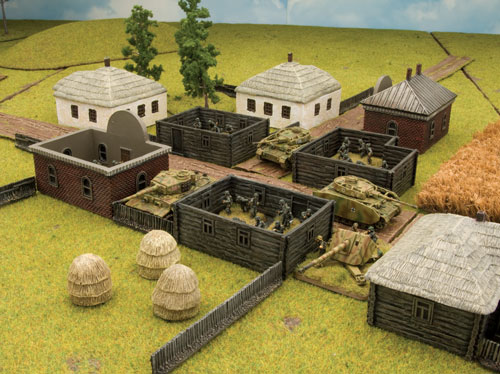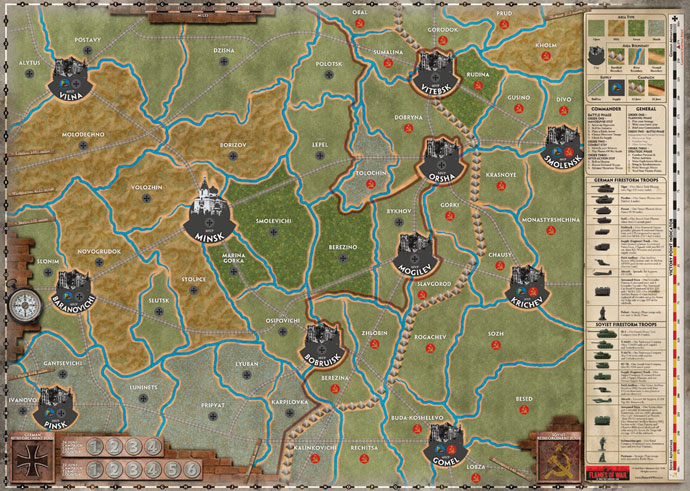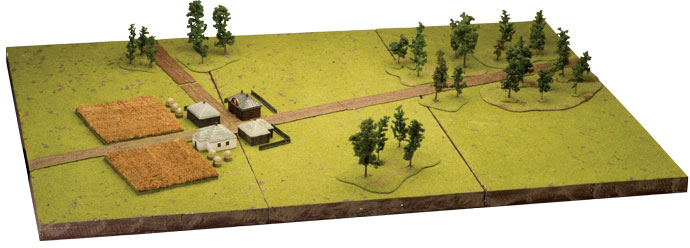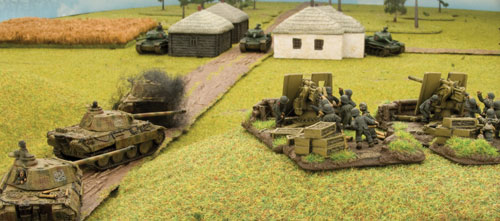|
|
|
|
Products mentioned in this Article
--None--
|
|
|
|
|
|
|
|
|
 |
|
|
 |
Byelorussian Battlefields
All Flames Of War battles need terrain! Battles in the Second World War were rarely fought over open plains with unobstructed lines of sight. In Flames Of War, wide open tables are extremely boring to play because they inevitably turn into dull shooting matches. Adding just a little terrain will give your game all sorts of flavour as your troops manoeuvre across the table!
Download the Firestorm-Bagration terrain guide (PDF)...
|
|
Firestorm Areas
The area types on the Firestorm campaign map help suggest how to set up your battlefield, but you are by no means limited by that suggestion when setting up your board. For example, a battle in an area with hills might mean that you place a few more hills than you would normally have on your table.
Placing Terrain
You don’t need lots of terrain to make your table an exciting battlefield! Covering about a third of your board with terrain is usually enough to fight a Flames Of War battle.
|
 |
|
When placing terrain, group similar pieces
together, such as trees or buildings. This helps the landscape look
more natural. Make your terrain the focus of your battles by placing
pieces, such as villages or hills, at key locations on the table.
Terrain should be something to fight over, not something to avoid!
Also try using the same table setup to play different missions. Each separate mission will play differently on the same table. For example, playing an Encounter mission on a river table will pose a completely different set of challenges than playing a No Retreat mission on the same table.
Always discuss the terrain with your opponent and agree on how to treat each feature before the game. Most of all, have fun and experiment with your terrain!
|
 |
Woods
A common misconception about wooded tables is that they must be crowded wall-to-wall with trees. However, that just would not be fun to play on. Place woods to give both players a challenge, but not so as they close off parts of the table. With a little thought, even a small amount of wooded terrain has a significant impact on the table, while still being fun to play on.
|
Marsh & Swamp tables
A large number of Soviet breakthroughs during Operation Bagration were made through wooded swamps and marshes. The German Army was simply not expecting large assaults through such inhospitable terrain! Marsh tables do not need to be open. By adding a little more cover such as trees and fields the table will produce more exciting action!
|
Hill Tables
As with wooded tables, hill tables are not required to have hills from one end of the table to the other. A hill table could simply have a couple more hills than your typical table. When modelling hills remember WYSIWYG, What You See Is What You Get, so treat each hill exactly as it is modelled! Experiment with more terrain to see how adding an extra field, hill or woods will affect the outcome of the game!
|
 |
Cities, Villages and Farmsteads
You could represent city fights in your Firestorm games using a village like the one shown in the picture below. You can also play on a table with several larger industrial buildings along with the other smaller buildings. You can even play a game using the city’s defences on a table with no buildings at all, representing the fight over the defences on the outskirts of a town. Villages and farmsteads were very common throughout Byelorussia and can appear in any sort of terrain.
|
Rivers
From large rivers such as the Dnepr and the Dvina to small ones that barely warrant a name on a map, rivers dominated the lowland areas of the Byelorussian Front. Whatever the size, both the Germans and Soviets used these formidable obstacles as natural fortifications because the crossings provided ideal choke points to stem the enemy advance.
|
Last Updated On Friday, May 28, 2010 by Wayne at Battlefront
|
|
|